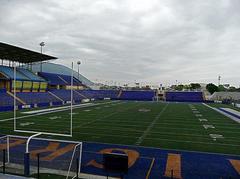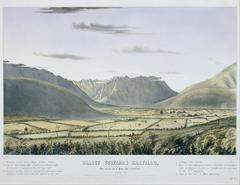
Zaragoza Monterrey, Mexico: Visiting Hours, Tickets, and Historical Sites Guide
Date: 04/07/2025
Introduction: Zaragoza in Monterrey—History and Significance
Zaragoza, a distinguished neighborhood within Monterrey, Nuevo León, Mexico, stands as a testament to the city’s enduring legacy and dynamic cultural landscape. Established alongside Monterrey itself in 1596, Zaragoza evolved from fertile colonial farmlands near the Sierra Madre Oriental into a vibrant urban hub at the heart of the city (mexico-newsletter.com; audiala.com). Its rich past includes pivotal roles in the Mexican-American War, the country’s industrial revolution, and modern cultural development.
Today, Zaragoza is celebrated for its lively plazas, historic churches, bustling markets, and thriving arts scene. Notably, it hosts events such as the Festival Internacional de Santa Lucía, attracting visitors from across the region (gotraveltipster.com). At the center lies Plaza Zaragoza, Monterrey’s historic heart, surrounded by architectural landmarks like the Palacio de Gobierno and the Faro del Comercio (audiala.com; lonelyplanet.com). The neighborhood’s accessibility via public transportation makes it an inviting gateway to explore Monterrey’s heritage.
This guide provides an in-depth overview of Zaragoza’s historical evolution, cultural highlights, practical visitor information, travel tips, and recommended attractions—offering insights for travelers seeking a meaningful Monterrey experience (Travel by Mexico; Passporter).
Table of Contents
- Early Origins and Colonial Foundations
- 19th Century: Growth, Reform, and Conflict
- Industrialization and Urban Expansion
- 20th Century: Modernization and Social Change
- Notable Historical Events and Figures
- Cultural Significance and Community Life
- Urban Development and Modern Identity
- Visiting Zaragoza Monterrey: Hours, Tickets, and Travel Tips
- Plaza Zaragoza: Historical and Civic Importance
- Discover Zaragoza: Visiting Hours, Tickets, and Must-See Historical Sites
- Visitor Experience and Practical Tips
Early Origins and Colonial Foundations
Zaragoza’s roots are closely tied to Monterrey’s foundation in 1596 by Diego de Montemayor (mexico-newsletter.com). The area was originally part of extensive land grants to Spanish settlers, serving as the agricultural and ranching backbone near the Santa Catarina River and the Sierra Madre Oriental (audiala.com). Early economic activity centered on agriculture and livestock, laying the groundwork for future urban development.
19th Century: Growth, Reform, and Conflict
Following Mexico’s independence in 1821, Zaragoza experienced significant political and social transformation. Land reforms and secularization characterized this period, while Monterrey’s strategic location made it a focal point during the Mexican-American War (1846–1848). Zaragoza served defensive purposes, and figures like General Mariano Escobedo were instrumental in the city’s resistance (mexico-newsletter.com).
Industrialization and Urban Expansion
The late 19th and early 20th centuries marked a period of rapid industrialization. The establishment of Fundidora Monterrey in 1900 catalyzed urban growth, drawing diverse populations and accelerating economic development. New railways and transportation networks linked Zaragoza more closely to the expanding city (mexico-newsletter.com).
20th Century: Modernization and Social Change
Modernization brought new housing, schools, and public spaces to Zaragoza, reflecting Monterrey’s urban planning vision (gotraveltipster.com). Cultural life flourished, with festivals such as the Festival Internacional de Santa Lucía enriching the neighborhood’s identity.
Notable Historical Events and Figures
Beyond its founders, Zaragoza’s residents have played key roles in Monterrey’s industrial and social progress—through factory work, entrepreneurship, and community organization (mexico-newsletter.com). The district has shown resilience in the face of natural disasters, prompting continual improvements to local infrastructure.
Cultural Significance and Community Life
Zaragoza is renowned for its lively plazas, historic churches, and markets. Traditional customs, such as religious processions, coexist with vibrant arts, murals, and music festivals (gotraveltipster.com). The neighborhood’s culinary scene features Monterrey specialties like cabrito and machacado con huevo (audiala.com).
Urban Development and Modern Identity
Efficient metro and bus systems connect Zaragoza to Monterrey’s commercial and cultural centers (audiala.com). Recent urban renewal initiatives have skillfully blended colonial architecture with modern design, reflecting Zaragoza’s evolving city identity.
Visiting Zaragoza Monterrey: Hours, Tickets, and Travel Tips
Visiting Hours and Tickets
Zaragoza is an open neighborhood accessible year-round without entry fees. Historic sites such as churches and cultural centers typically operate between 9:00 AM and 6:00 PM. Guided tours and special event tickets—like those for the Festival Internacional de Santa Lucía—can be purchased online or at venue entrances. Always consult official websites or local tourism offices for the latest updates.
Guided Tours and Accessibility
Walking tours of Zaragoza are widely available and highlight historical landmarks, murals, and culinary hotspots. The neighborhood is served by Monterrey’s metro Line 1 (Zaragoza station) and several bus routes, and is increasingly pedestrian-friendly. Accessibility features such as ramps and accessible transport options are improving.
Nearby Attractions
Key attractions near Zaragoza include Fundidora Park, Macroplaza, and the Museum of Contemporary Art. These sites are easily accessible by public transit and complement the historical and cultural experience.
Travel Tips
- Visit during the Festival Internacional de Santa Lucía (September–October) for cultural performances.
- Sample local dishes like cabrito and machacado con huevo at traditional eateries.
- Wear comfortable shoes and bring sun protection.
- Monitor weather forecasts, especially during hurricane season.
Plaza Zaragoza: Historical and Civic Importance
Origins and Evolution
Plaza Zaragoza has served as Monterrey’s central gathering place since the colonial era (audiala.com). It witnessed key historic events, from independence celebrations to major civic movements, and remains a living chronicle of the city’s development (magicaltowns.mx).
Architectural and Artistic Features
The plaza is surrounded by significant buildings, including the Palacio de Gobierno, and is adorned by the Fuente de la Vida fountain (audiala.com). The Faro del Comercio, a 70-meter-tall modern monument emitting a green laser at night, symbolizes Monterrey’s progress (lonelyplanet.com).
Civic Life and Community Events
Plaza Zaragoza is the epicenter of public life, hosting concerts, festivals, and ceremonies (lonelyplanet.com). Everyday activity includes street vendors, artisans, and live performances (mexicotravel.blog). During weekends, art fairs and pop-up markets add to the vibrancy.
Cultural Significance and Identity
The plaza’s enduring presence makes it a symbol of Monterrey’s resilience. Its proximity to Barrio Antiguo links the city’s colonial heritage with contemporary culture (magicaltowns.mx). Events often feature Norteño and cumbia music, and local artists contribute to its lively atmosphere (explorecity.life).
Accessibility and Visitor Experience
Easily accessible by public transport, Plaza Zaragoza is pedestrian-friendly, shaded, and well-lit (magicaltowns.mx). Nearby attractions include the Metropolitan Cathedral and Palacio del Obispado (touristplatform.com). The plaza is designed for comfort and security, with regular police presence (howsafeismexico.com).
Visitor Information
- Hours: Open daily, 6:00 AM–11:00 PM
- Admission: Free
- Guided Tours: Available from local operators, bookable online or via agencies
- Accessibility: Ramps, smooth walkways, tactile paving, and sign language interpretation for some events
Travel Tips
- Getting There: Multiple bus routes and nearby taxi stands; parking within five minutes’ walk
- Best Times: Evenings and weekends for lively events; Christmas season for festive decor
- Dining: Try local specialties at nearby cafes and restaurants (howsafeismexico.com)
- Special Events: Watch for the Festival Internacional de Santa Lucía and Independence Day celebrations
Integration with Monterrey’s Urban Fabric
Plaza Zaragoza connects seamlessly with the Macroplaza and is a gateway to Monterrey’s civic and cultural institutions (wideworldtrips.com). Recent urban planning ensures its ongoing relevance and historical integrity (audiala.com).
Role in Civic Identity and Memory
The plaza is a site for collective memory, hosting milestones from weddings to protests, and remains central to the city’s identity (explorecity.life).
Discover Zaragoza: Visiting Hours, Tickets, and Must-See Historical Sites
Plaza Zaragoza
- Hours: 6:00 AM–10:00 PM, daily
- Admission: Free
- Highlights: Statue of General Ignacio Zaragoza, Fuente de la Vida fountain, and frequent cultural events (Travel by Mexico)
Surrounding Landmarks
- Palacio Municipal de Monterrey: Neoclassical architecture
- Monumento al Sol: Modernist art by Rufino Tamayo
- Catedral Metropolitana de Nuestra Señora de Monterrey: Architectural blend of styles
- Museo de Arte Contemporáneo (MARCO): 10:00 AM–6:00 PM, ~MXN 70
- Museo Metropolitano de Monterrey: Rotating exhibits in a historic setting
Macroplaza
- Hours: Open 24 hours
- Admission: Free
- Features: One of the world’s largest public squares, monuments, green spaces (Triplyzer)
Barrio Antiguo
- Hours: Shops/museums 10:00 AM–7:00 PM; nightlife after 8:00 PM
- Admission: Varies by venue
- Highlights: Colonial architecture, nightlife, museums
Museo del Obispado
- Hours: Tues–Sun, 10:00 AM–6:00 PM
- Admission: ~MXN 30
Natural Attractions Near Zaragoza
- El Salto Recreational Park: 3 km south, 8:00 AM–6:00 PM (Spero Hope)
- Grutas de García: 9:00 AM–5:00 PM, guided tours, ~MXN 130
- Cola de Caballo Park: 8:00 AM–7:00 PM, ~MXN 40
Visitor Tips
- Accessibility: Most main sites are wheelchair accessible
- Safety: Central areas are generally safe; use standard precautions (Mexico Travel Secrets)
- Best Time: October–April for mild weather
- Cuisine: Try cabrito, machaca, and carne asada at local restaurants
Visitor Experience and Practical Tips
Navigating Zaragoza
Plaza Zaragoza is next to the Macroplaza and major roads. Easily reached by metro (Zaragoza Station, Line 2) and buses (Wanderlog). The area is pedestrian-friendly with gardens and wide walkways.
Suggested Itineraries
- One hour: Enjoy the plaza, fountain, and cathedral
- Half day: Add Macroplaza, Barrio Antiguo, and MARCO
- Three days: Explore all main sites and surrounding natural attractions (Passporter)
Safety and Local Customs
- Daytime and early evenings are safest (How Safe is Mexico; Safe Travel Guide)
- Secure valuables and avoid isolated areas at night
- Tipping (10–15%) is customary; dress neatly in religious and historic sites
Frequently Asked Questions (FAQ)
Q: Are there entrance fees for Plaza Zaragoza?
A: No, it’s a public space with free access.
Q: What are the hours for the Metropolitan Cathedral?
A: Usually 9:00 AM–6:00 PM, but check for holiday changes.
Q: Are guided tours available?
A: Yes, through local operators and online platforms.
Q: Is Zaragoza safe at night?
A: Safer during daylight and early evening; exercise caution at night.
Q: Are there major events at Zaragoza?
A: Yes, including Independence Day and the Festival Internacional de Santa Lucía.
Visual Enhancements
[Insert images: Historic church in Zaragoza Monterrey; Festival Internacional de Santa Lucía in Zaragoza Monterrey; Map of Zaragoza neighborhood in Monterrey]
Interactive Map of Zaragoza and Surrounding Attractions
Conclusion and Recommendations
Zaragoza is a dynamic blend of history, culture, and urban life. Open daily and easily accessible by public transportation, it offers an enriching experience for all types of travelers. The area’s historic architecture, lively festivals, diverse cuisine, and proximity to both urban and natural attractions make it an unmissable Monterrey destination.
For up-to-date information, guided tour bookings, and event calendars, download the Audiala app and follow official tourism resources.
References & Further Reading
- History of Monterrey Mexico, 2025, Mexico Newsletter
- Monterrey Travel Guide, 2025, GoTravelTipster
- Zaragoza Neighborhood and Attractions, 2025, Audiala
- Barrio Antiguo Monterrey, 2025, Magical Towns
- Plaza Zaragoza, 2025, Lonely Planet
- Things To Do in Monterrey, 2025, Mexico Travel Blog
- Monterrey Attractions, 2025, Travel by Mexico
- Plan Trip Monterrey, 2025, Passporter
- Is Monterrey Safe?, 2025, How Safe is Mexico




